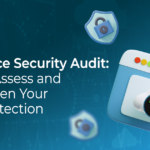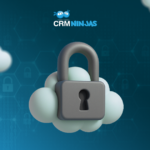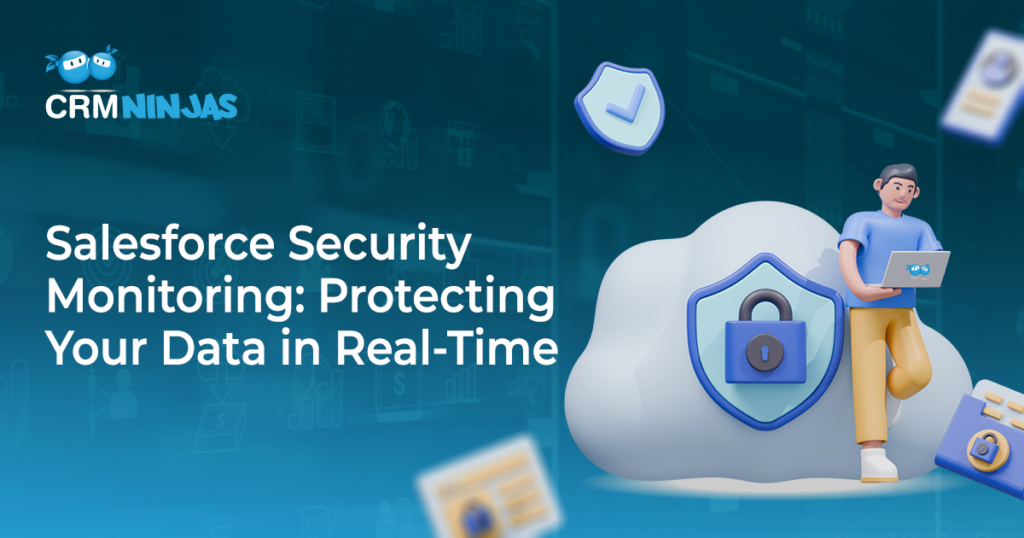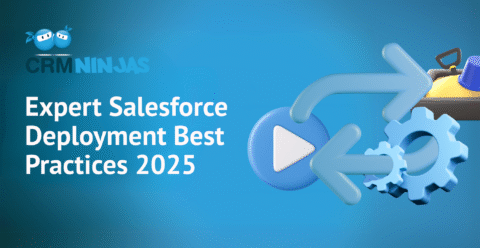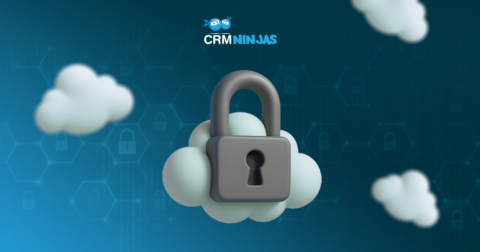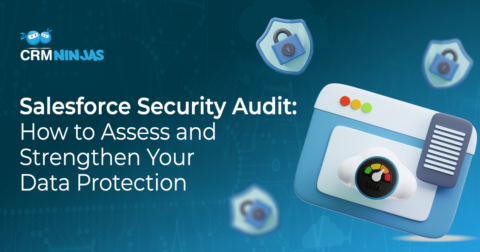Salesforce security monitoring may mean different things to different organizations. Some might argue that true security monitoring doesn’t quite exist, while others are tasked with putting in place measures to protect their Salesforce environment from potential threats.
If you’re worried about things like data leaks, unauthorized access, or API risks, Salesforce has some tools to help keep everything secure. Features like Health Check, Salesforce Shield, and Security Center let you keep an eye on user activity, apply key security settings, and even encrypt sensitive data, making it easier to protect important data.
As we take a closer look at these tools, keep in mind that Salesforce security isn’t a one-size-fits-all solution. Let’s explore how you can fine-tune your Salesforce security monitoring.

Expert Help to Safeguard Your Data
CRMNinjas’ security solutions put professionals in your corner to reinforce your operations and make your Salesforce instance airtight.
Common Security Threats and Vulnerabilities in Salesforce Environments
First, let’s look at some of the common security threats in Salesforce. While Salesforce is built with advanced security to protect your data and applications, even the best systems face challenges that require proactive Salesforce security monitoring.
Salesforce Comes with Security Challenges that Require Attention
Your Salesforce data could be exposed to unauthorized users throughout your organization because of broad permissions and incorrect sharing rules. Without strong password policies or multi-factor authentication (MFA), unauthorized users can gain access to sensitive data, whether accidental or intentional, increasing the risk of data breaches.
In addition, while APIs enable integration between Salesforce and third-party apps, this flexibility increases the risk of unauthorized access and data breaches if not properly secured.
Keeping your organization’s data safe isn’t a one-time task; it requires continuous Salesforce security monitoring. With the right tools, you can stay ahead of potential threats before they become serious issues. For example, Event Monitoring allows you to keep an eye on user activity, like logins and report exports, almost in near real-time, helping you spot anything unusual right away.
Other helpful tools include Salesforce Health Check, which scans your security settings for any weak spots, and Salesforce Shield, which adds extra layers of protection like data encryption and field audit trails.
Before diving into the details of some of these key Salesforce security features, which demonstrate how continuous Salesforce security monitoring protects your organization’s data, let’s understand the four levels of security that are already integrated into Salesforce to help protect your data.
What Are the Four Levels of Salesforce Security Monitoring?
Salesforce has four levels of security to help protect your data, and its setup lets you control who can access what, based on your business needs.
Four Levels of Security
Salesforce’s security model includes four levels of data access:
- Organizational,
- Object,
- Field, and
- Record
Each providing a different layer of protection to your Salesforce data.
At the organization level, you can manage who can log in, set password rules, and restrict access based on a user’s time or location. At the object level, you can decide what users can do with specific types of data, like allowing one user to only read and create records while another may read and edit them.
Field-level security goes even further by restricting access to specific fields within an object. For example, you can hide a candidate’s social security number from interviewers while making it visible to hiring managers. 
Lastly, record-level security makes sure that users can access some records but not others, even if they have permission to view the overall object. This helps fine-tune who sees what within the system.
How Do I Check Security in Salesforce?
Salesforce has tools that can encrypt data, track user activity, and check your system’s security. By using them, you can stay ahead of security threats and keep your data protected from unauthorized access.
Take Advantage of Salesforce Security ToolsOne of the most powerful security tools is Salesforce Shield, which includes Platform Encryption, Event Monitoring, and Field Audit Trail. Platform Encryption makes sure that any sensitive data is securely stored, while Event Monitoring keeps an eye on user activity, helping spot any unusual behavior.
Salesforce has tools that can encrypt data, track user activity, and check your system’s security. By using them, you can stay ahead of security threats and keep your data protected from unauthorized access.
Take Advantage of Salesforce Security Tools
One of the most powerful security tools is Salesforce Shield, which includes Platform Encryption, Event Monitoring, and Field Audit Trail. Platform Encryption makes sure that any sensitive data is securely stored, while Event Monitoring keeps an eye on user activity, helping spot any unusual behavior.

Taylor Smith, Partner at CRMNinjas, highlights the importance of Salesforce Shield’s Event Monitoring feature in identifying and responding to suspicious user activity. “You can have alerts for suspicious user activity. Did someone log in from Dubai? That’s suspicious activity, right? You can have alerts pop up with Event Monitoring,” Taylor adds.
Field Audit Trail keeps a history of important data changes, making it easier to track updates and stay compliant with regulations.
Another great tool is the Security Center, which helps organize all of your permissions and controls into a single comprehensive view, helping identify potential misconfigurations or incorrect user permissions and addressing any gaps in your organization’s data security.
Similarly, Health Check evaluates an organization’s security settings against Salesforce’s best practices, giving a security score and clear recommendations for improvement.
Regularly using these Salesforce security tools helps keep your organization’s data safe while making sure that the platform remains secure and reliable for your users.
How CRMNinjas Approaches Salesforce Security Monitoring
In addition to continuous Salesforce security monitoring, at CRMNinjas, we can help you take a proactive approach to keep your organization’s Salesforce data secure.
Best Practices for Ongoing Salesforce Security Monitoring
Some key best practices we can help you implement to prevent security threats and potential data loss include regular data backups, and we encourage using Salesforce’s manual backup options like Data Export Service and Report Exports. These allow you to schedule and perform backups at regular intervals to make sure that your Salesforce data can be recovered in the event of loss.
In addition, we emphasize the importance of implementing strong access controls and recommend that you limit your administrative privileges and clearly define user roles to reduce the risk of intentional or accidental data theft or loss.
Advanced security measures will also be important to help protect your Salesforce data, like performing regular security audits, and putting in place strong password policies and multi-factor authentication to protect against security threats.
Beyond backups, maintaining data integrity is crucial. That’s why we recommend performing regular data integrity checks using Salesforce’s Data Quality Analysis Dashboards to identify deficiencies in record data.
By adopting these best practices, you can strengthen your Salesforce security monitoring, minimize risks, and maintain control over your data.

Find Out Where Your Salesforce Org Stands
Whether you’re worried about user permissions or just haven’t looked at your org’s health check in a while, we’ve got you covered.
CRM Ninjas offers a free, no-strings-attached Salesforce Security Audit to help you spot vulnerabilities before they turn into real problems.
- Review your org’s current security posture
- Run a full Security Health Check
- Identify high-risk misconfigurations
- Provide clear, actionable next steps
Get your free courtesy consultation today to put your mind at ease.
Salesforce Security Monitoring: Frequently Asked Questions (FAQ)
What are the 4 levels of security in Salesforce?
Salesforce uses four layers of security to protect data and manage access:
- Organization-Level Security – Controls who can log in and from where.
- Object-Level Security – Sets user access to specific Salesforce objects.
- Field-Level Security – Hides or shows individual data fields.
- Record-Level Security – Limits access to individual records within an object.
Each level ensures Salesforce users only access the data they need—reducing security risks.
How do you check security settings in Salesforce?
To check security in Salesforce, use built-in tools like:
- Salesforce Health Check – Scores your org’s security settings against best practices.
- Salesforce Shield – Offers Event Monitoring, Platform Encryption, and Field Audit Trail.
- Security Center – Gives a centralized view of user permissions and access risks.
- Login History & Audit Trail – Helps track login attempts and configuration changes.
These tools help maintain compliance and improve your Salesforce security monitoring efforts.
What is Salesforce security monitoring?
Salesforce security monitoring is the process of continuously tracking user activity, data access, and system changes to detect security threats in real-time.
It uses tools like Event Monitoring and Audit Trails to monitor logins, report exports, API activity, and admin changes—helping organizations prevent unauthorized access and data breaches.
How does Salesforce ensure data security?
Salesforce ensures data security with:
- Multi-layered access control (org, object, field, record levels)
- Real-time monitoring using Salesforce Shield and Security Center
- Data encryption through Platform Encryption
- Compliance tools like Health Check and Field Audit Trail
These features provide a secure, scalable environment for managing sensitive CRM data.
